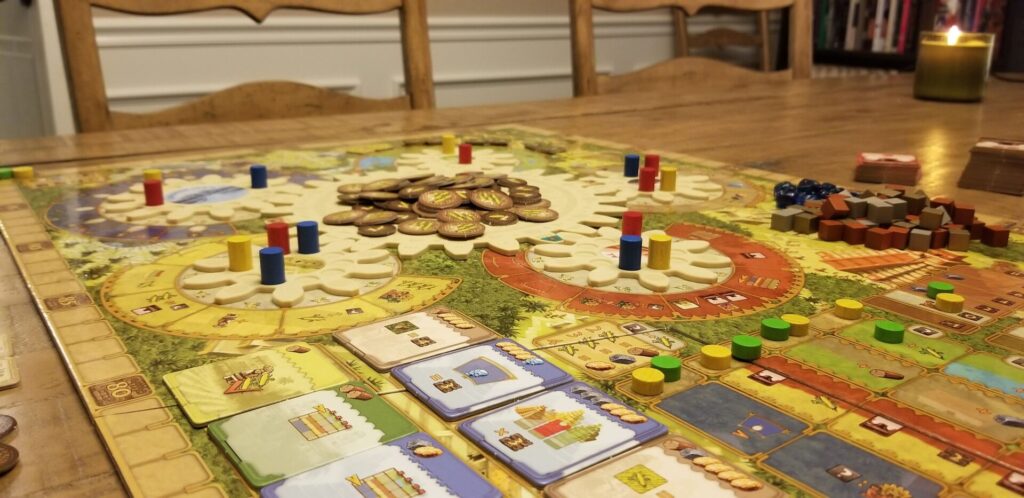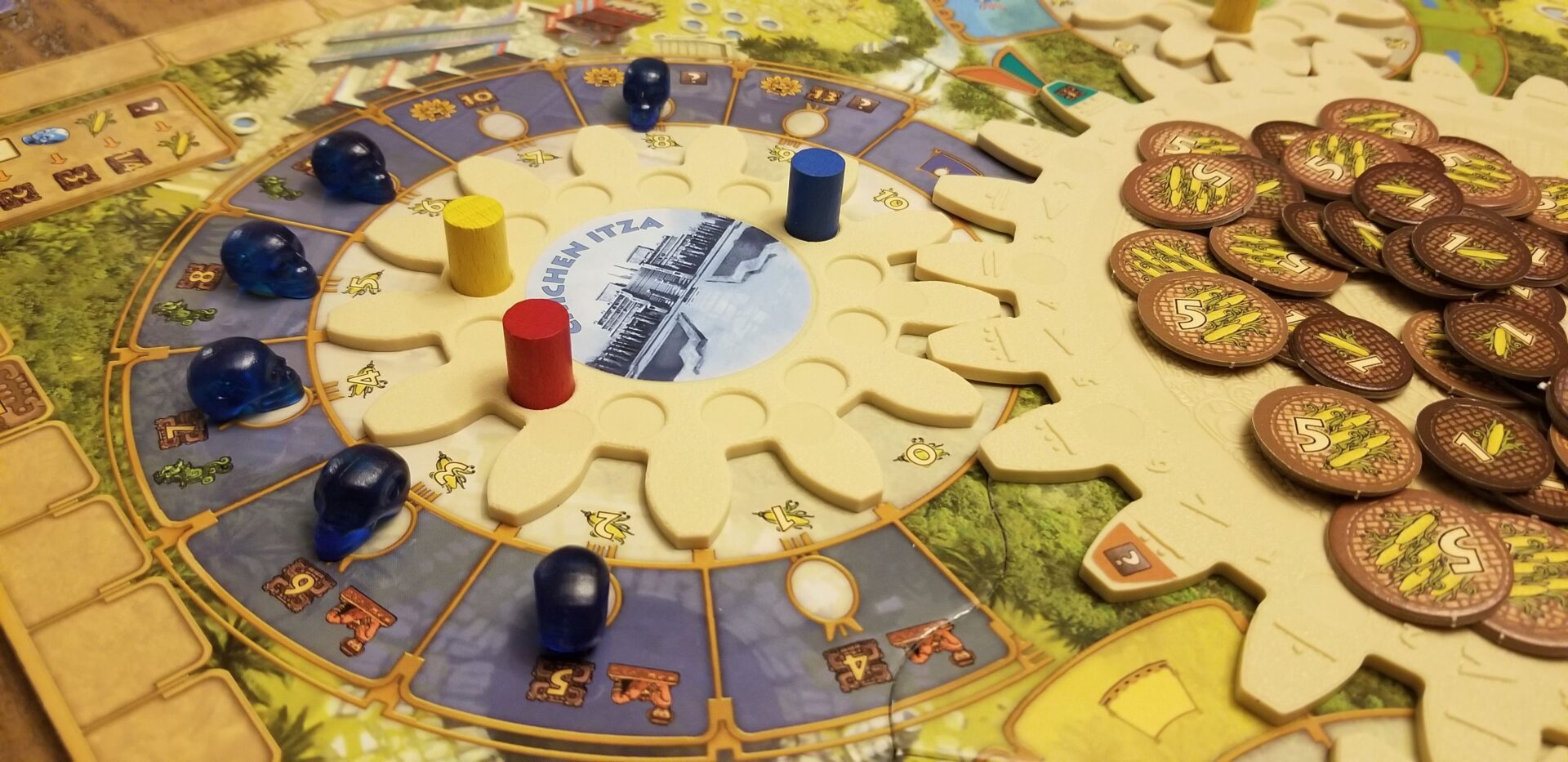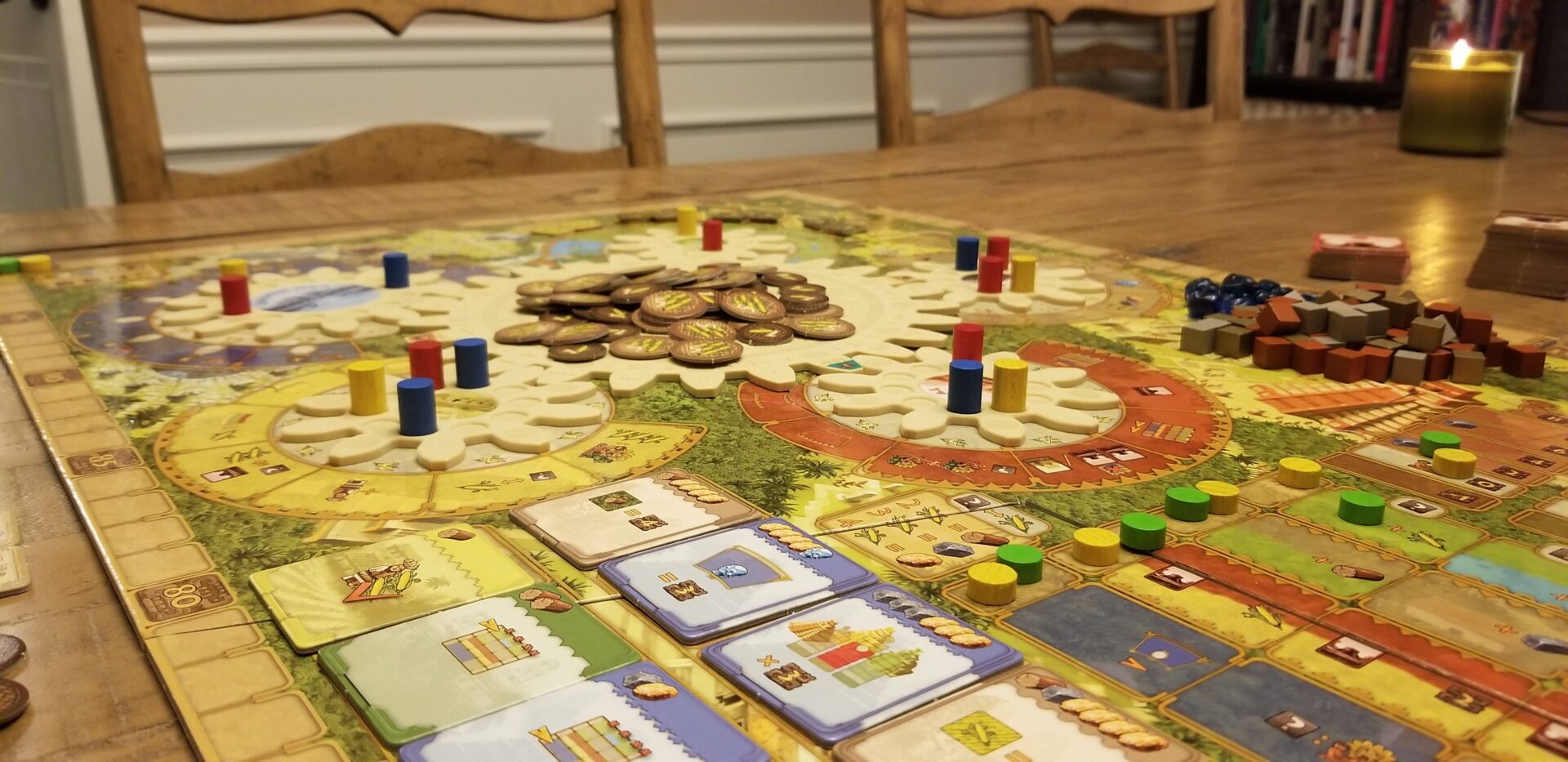
Name: Tzolk’in – The Mayan Calendar
Year of Release: 2012
Player Count: 2 – 4 Players (1 Player with fan-made variant)
Playing Time: 90 minutes
Designer: Simone Luciani, Daniele Tascini
Publisher: Czech Games Edition
Primary Mechanisms: Worker Placement, Rondel
Weight (According to boardgamegeek.com): 3.67
Overview
For this review, I played the 1-player variant posted by user Cherey around 4 years ago. You can find the .pdf posted in the files section, and you’ll see there are two different variants included in the document. I have been trying out the version with the virtual player. You can also click the link here to go straight to the file posted on boardgamegeek.com.
I typically like to review all parts of the game but since this game has been out for quite some time, I am just going to focus on this particular variant. Now that my gears are turning, let’s get started!
Setup
The setup to Tzolk’in is probably on the longer side of the games I own. It takes somewhere between 15 and 20 minutes in my experience. The setup for the solo variant is in that same ballpark as you mirror the original game’s setup fairly closely. The variant’s main difference is that you need a 6-sided dice to make it work. During setup, you roll the dice for each gear and you place one of the virtual player’s workers in the appropriate slot on the gear.
There is a small change on how the virtual player chooses the starting wealth tiles in that it doesn’t feel the need to feed it’s workers nor does it need corn or resources. With this in mind, you end up giving out either victory points or crystal skulls to the virtual player when it comes to the starting tiles.
Other than these changes, you still put out the workers for the other two colors to take up some of the gears’ spaces. You still put out monuments and buildings, corn and wood tiles, and you still place the markers (for yourself and the virtual player) on all three temples and all four technology tracks. Once complete, the game can begin!
Gameplay

As mentioned, this variant’s setup is closely related to the original game so you might be asking “how much different is the gameplay?” Well, the answer is varied. When taking your turns, it actually doesn’t feel much different. On the other hand, when it comes to playing the virtual player’s turn, you literally need an extra 8-page document to complete their turns as well as that aforementioned die.
Remember back during setup, we placed one virtual worker on each gear? Now it is their time to shine! When you conduct the virtual player’s turn, you roll the die. Numbers 1 through 5 each correlate to one gear on the board (viewing them clockwise from top left.) Number 6 is reserved to trigger the “Start Player” action by the virtual player. Once you roll the die, you match the number up with the correct gear, then you check to see which action the virtual player’s worker is on. At this point, you need to consult the extra rule book to see how the virtual player reacts to that action.
Sometimes these actions are as simple as awarding victory points, since the virtual player doesn’t need resources. They can also be as cumbersome as awarding an enhancement on one of the technology tracks. In this case, you must roll the die to see if you get an even or odd number. Then roll it again to see what your next number is. Based on the combination of even and odds, you have to consult the solo variant .pdf to figure out which technology track correlates to this combination of die rolls.
There is a lot of consulting of this other document, but it is laid out very nicely and the author is very clear in all of the descriptions of the actions. If you don’t mind the idea of using this aide, I definitely recommend trying this variant out. And who knows, maybe once you play it enough, you wouldn’t need to refer to this document much, but I’ve played three times and still need the help.
The game plays quickly even with this added nuance. The reason being (at least in my opinion) is there is no AP happening with the virtual player like there is in this game when playing with a real player. Roll the die, check the manual, do the action…. Back to your turn! My games have lasted around 45 minutes to an hour which is quicker than the games of Tzolk’in I’ve played with my wife.
Conclusion
With all that being said, is the variant fun? I have mixed feelings. The biggest negative is that the virtual player is so overpowered that I almost don’t understand how I could possibly win. I don’t mind a challenge, but this is almost unmanageable.
The overpowered-ness (is that a word?) comes from one tiny aspect of the variant so I think it might be able to be tweaked to bring some more balance, but I’m not smart enough to figure it out. The aspect is that the virtual player never has to remove her worker from the gear. In a multiplayer game, my opponent might wait 6 turns to let her worker ride to a powerful action but that’s 6 turns they aren’t able to use that worker for other actions. And once she activates the action, the worker is removed and would have to start at the bottom of another gear the next turn.
In this variant, it is fully plausible for a 5 to be rolled, activating the Chichen Itza gear. The virtual player would get to place a crystal skull, award themselves the victory points (we’ll say 9 for this example) and move up one spot on the appropriate temple. But the worker is not removed so on the next turn, another 5 is rolled. With the gear being moved between turns, the virtual player worker is now sitting at the spot that will give them 10 victory points as well as another move up the temple. Sure, this is possible in the multiplayer game, but my opponent would have had to sink two workers into that gear as well as countless turns. Maybe I’m playing the variant wrong, but this just seems too powerful to overcome.
I will keep the printed out single player aide in the box if there is another time that I just really need to play Tzolk’in solo but don’t see myself running back to this variant anytime soon.
Rating
Ratings are based on 5 main criteria: rulebook, setup, components, art & graphic design, and gameplay. The first 4 criteria are rated 1 to 5 and the gameplay is rated 1 to 10. These scores culminate in an “overall satisfaction” score that is rated from 1 to 10. If the reviewed game has both a solo and multiplayer mode, I have assigned scores separately to give context to which mode we enjoy more.
Links
As an Amazon Associate I earn from qualifying purchases.

